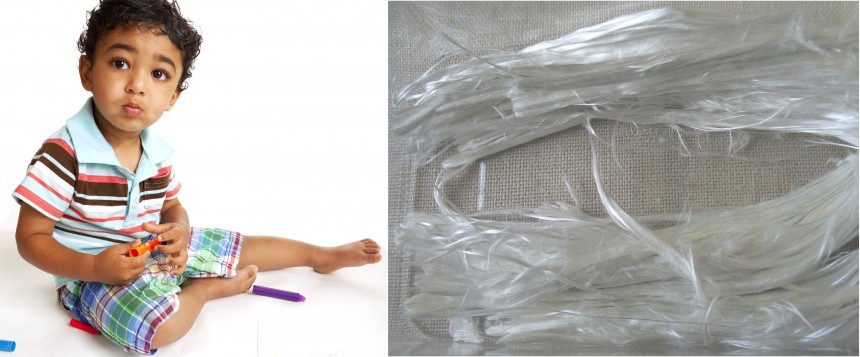
Photo: mitgirl – Fotolia/Aram Dulyan
Traces of asbestos have been found in some children’s crayons and crime lab play kits sold in the US. This has raised concerns because asbestos is known to cause lung damage and cancer, as well as other diseases. While child health experts in the US worry about asbestos exposure from crayons, children in India are exposed to asbestos on a much larger scale, literally from the roof over their heads.
According to experts, exposure to asbestos for even a few days can have serious ill-effects on health. Inhaled asbestos particles can lead to serious problems such as cancer in the lungs and the mesothelium, a membrane that surrounds internal organs. There is no safe level of exposure to asbestos.
Asbestos is a naturally occurring mineral that is desired for its heat and fire-resistance properties. Asbestos is fiber-like or flaky in nature, resembling soan papdi. It can be mixed with cement or woven with fabric. While it was used extensively during the 1900s, in the last 30 years its use has been banned by countries in Europe, Japan, South Korea, and Turkey. Although asbestos is not banned in the US and Canada, its use there has been severely limited due to its harmful effects and civil lawsuits by those who fell sick after exposure to asbestos.
India, meanwhile, is one of the the world’s largest importer of asbestos, according to the Associated Press. Most of the asbestos is mixed with cement to make corrugated roof sheets, wall panels and pipes.
Most asbestos is produced by Russia, China, Brazil and Kazakstan. Canada was also a relatively smaller producer and exporter of asbestos until 2011, but all mining ceased that year.
According to a report commissioned by the Environmental Working Group Action Fund, an advocacy organization in the U.S., 4 out of 28 brands of crayons that were tested contained asbestos. Two out of 21 children’s crime lab kits contained asbestos in a fingerprint detection powder.
There is a high chance that children may inhale some particles of the fingerprint powder while playing with it. Crayons could be eaten by young children. Once the asbestos enters their bodies, the children would be at risk of developing diseases that can take years to develop.
“Asbestos in toys poses an unacceptable risk to children, today as it did in 2000 and 2007, the last time tests found the deadly substance in these children’s products,” said Philip Landrigan, professor of paediatrics and preventive medicine at Mount Sinai Hospital in New York, in a statement. Though he reviewed the study, he was not involved in it.
“Some may say children are not at a very high risk of exposure, but children are much more reactive to toxic materials and we’re dealing with a carcinogen,” said Richard Lemen, retired U.S. assistant surgeon general who specialized in occupational health. “We haven’t identified a concentration or exposure below which we are at not risk.”
According to the report, it’s not certain why asbestos is being used in the crayons and kits. However, it is most probably a “contaminant of talc used as a binding agent in the crayons and in powder in the crime scene fingerprint kits,” Lunder and colleagues wrote. This conclusion was made as asbestos is often found close to talc deposits.
Asbestos was found in Amscan Crayons, Disney Mickey Mouse Clubhouse crayons, Nickelodeon Teenage Mutant Ninja Turtle Crayons, Saban’s Power Rangers Super Megaforce crayons, EduScience Deluve Forensics Lab Kit (black fingerprint powder), and Inside Intelligence Secret Spy kit (white fingerprint powder). All the products were manufactured in China. FamiLife has not determined whether these products are sold in stores in India. The tests for the material were conducted at the Scientific Analytical Institute in Greensboro, North Carolina.
Share your thoughts, leave a comment below. Please like FamiLife’s page on Facebook so that you get all our articles and others may find us.
